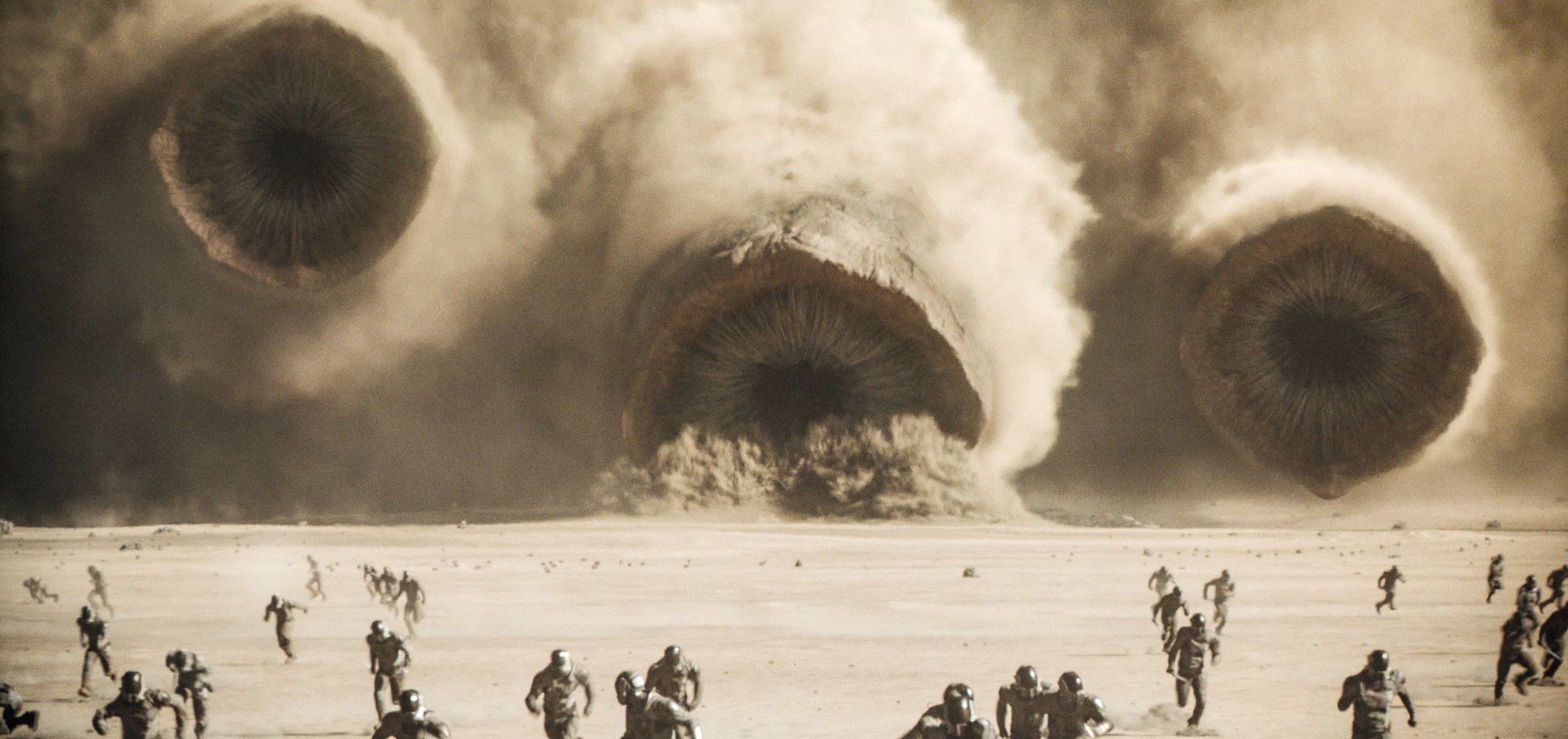Dune: Part Two
 for sequences of strong violence, some suggestive material and brief strong language.
for sequences of strong violence, some suggestive material and brief strong language.
Reviewed by: Keith Rowe
CONTRIBUTOR
| Moral Rating: | Offensive |
| Moviemaking Quality: |
|
| Primary Audience: | Mature-Teens Young-Adults Adults |
| Genre: | Sci-Fi Action Adventure Drama Sequel 3D IMAX |
| Length: | 2 hr. 46 min. |
| Year of Release: | 2024 |
| USA Release: |
March 1, 2024 (wide release) DVD: May 14, 2024 |
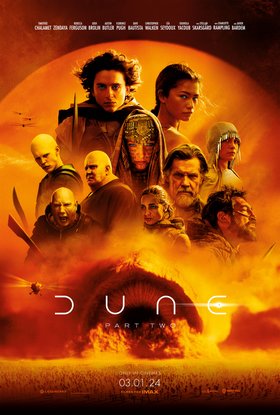

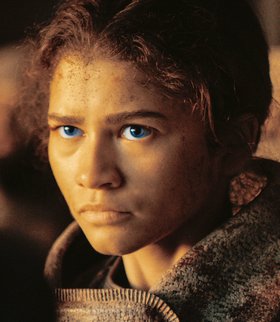

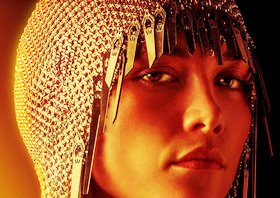
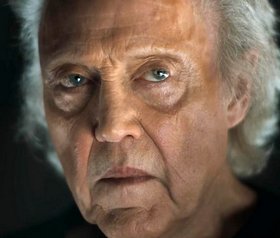

Film based on the work of author Frank Herbert (a non-Christian)
His writing were reportedly influenced by Sigmund Freud, Carl Jung, Karl Jaspers, Martin Heidegger, Zen Buddhism and the relationship between religion, politics and power.
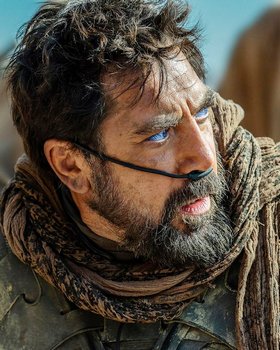
The Fremen are an analog for Arab Muslims and a holy war.
Hans Zimmer’s score sounds as if Arrakis were in the Middle East rather than space
Anti-colonial and ecologically dystopian tale
Indigenous people (the Fremen) with a tight relationship with the land (seeking to become “one with the desert”) being subjugated destroyed by outsiders with no care for them or the environment
The more natural and low tech defenders continually outwit the high tech invaders (the Harkonnens).
Main characters seeking revenge
A story of faith—both pure and manipulated
A telepathic fetus
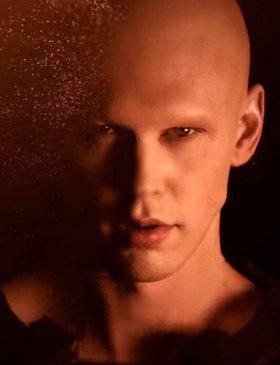
Sadistic violence
About murder
Hatred
Possible effects and consequences of using consciousness-altering chemicals
Stoking current racial and ethnic tensions by inserting racial and white-supremacism themes
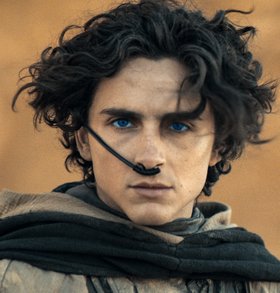
Messiah-figure
List of Messianic prophecies fulfilled by Jesus Christ
Facing a choice between the love of one’s life and the fate of the known universe
Ability to partially forsee the future
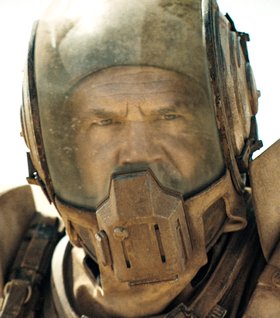
About deserts and wilderness in the Bible
What is the Biblical perspective on war? Answer
War in the Bible
Armies in the Bible
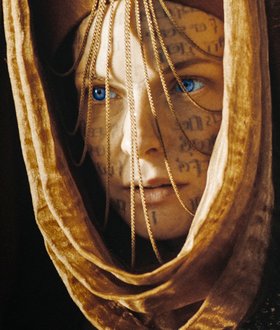
What does the Bible say about intelligent life on other planets?
Are we alone in the universe?
Does Scripture refer to life in space?
Questions and answers about the origin of LIFE
 Who is Timothée Chalamet?
Who is Timothée Chalamet?
 Who is Zendaya?
Who is Zendaya?
| Featuring |
Timothée Chalamet … Paul Atreides, aka Muad'Dib Zendaya … Chani Florence Pugh … Princess Irulan Corrino Rebecca Ferguson … Lady Jessica Atreides Austin Butler … Feyd-Rautha Harkonnen Josh Brolin … Gurney Halleck Stellan Skarsgård (Stellan Skarsgard) … Baron Vladimir Harkonnen Dave Bautista … Glossu Rabban Harkonnen Javier Bardem … Stilgar Léa Seydoux … Lady Margot Christopher Walken … Emperor Shaddam IV, Emperor of the Known Universe Charlotte Rampling … Bene Gesserit Reverend Mother Mohiam, aka Gaius Helen Mohiam Anya Taylor-Joy … Alia Atreides, Paul Atreides’ sister who appears in his visions See all » |
| Director |
Denis Villeneuve |
| Producer |
Villeneuve Films Legendary Entertainmen See all » |
| Distributor |
 Warner Bros. Pictures, a Warner Bros. Entertainment Company |
Prequel: “Dune” (2021)
In “Dune: Part 1,” Paul Atreides (Timothée Chalamet) and his mother Lady Jessica Atreides (Rebecca Ferguson) set out across the deserts of Arrakis with Stilgar (Javier Bardem), Chani (Zendaya) and a host of nomadic Fremen.
“Dune: Part Two” picks up where the first film left off, with Paul and Lady Jessica learning the ways of the Fremen culture. One by one, Paul fulfills each part of an ancient prophecy, and though he’s reticent to accept such a mantle, the Fremen people revere him as their messiah (“Lisan al Gaib”). Things are also looking up for Lady Jessica, who becomes the new Reverend Mother for the Bene Gesserit sisterhood.
Meanwhile, the nefarious members of House Harkonnen are scheming to control all spice (mélange) production on arid Arrakis. When Rabban (Dave Bautista) fails to rout the Fremen, who are blowing up Harkonnen harvesters and spice depots with terrorist-style sneak attacks, Baron Vladimir Harkonnen (Stellan Skarsgård (Stellan Skarsgard)) commissions his brash nephew, Feyd-Rautha Harkonnen (Austin Butler), to find and destroy the Fremen stronghold to get spice production back on schedule.
When Padishah Emperor Shaddam IV (Christopher Walken) and his daughter Princess Irulan (Florence Pugh) arrive at Arrakeen, the major city on Arrakis, the board is set for a massive battle between the Emperor’s Sardaukar soldiers, the Harkonnen army and the Fremen freedom fighters (and let’s not forget the giant sandworms).
So, who wins the massive mêlée? Do Paul and Chani tie the knot? Does Paul get revenge for the murder of his father, Duke Leto Atreides (Oscar Isaac)?
Well, you don’t expect me to ruin everything do you? (Of course, if you’ve read Frank Herbert’s titular tome, you already know the answers.)
As you’ve probably guessed from the title, this is the second movie based on Herbert’s sci-fi masterwork, which was first published in 1965. With the smashing success of the first “Dune” (2021), this sequel was all but assured. But does “Part Two” live up to the previous film?
Some of my main criticisms of the first film were that its massive sets and ships made the characters seem insignificant by comparison and that the many frenetic ground battles felt impersonal since we really knew nothing about the soldiers charging into the fray. In “Part Two,” director Denis Villeneuve corrects these complaints by utilizing more closeups of the characters (especially the comely Irulan/Pugh) and by thrusting characters we’ve come to know (Paul, Stilgar and Chani) into the cataclysmic conflagrations. Villeneuve flips the script in several other key ways in the sequel.
For instance, much of the first film took place in and around Arrakeen (indoors). In this movie, most of the action transpires in the planet’s deserts (outdoors). In a similar vein, the first “Dune” focuses on the Atreides family, while “Part Two” centers on the Fremen people (and Paul and Lady Jessica’s rise among their ranks).
Another contrast is that the first film’s narrative is infused with Machiavellian machinations (a few instances remain here, like when Baron Harkonnen plots his nephew’s demise, or when Princess Irulan manipulates her father into saving Paul’s life), while this film is more concerned with the Fremen culture and how they seek to become “one with the desert.” In essence, the political intrigue of the first film yields to the religious fervor of the second film.
The new cast members shine, especially Pugh and Butler. Walken, however, seems weak and doesn’t have the bearing of a galactic ruler. Bautista, who reprises his role as the Harkonnen henchman, continues to be underserved. In a paper-thin characterization, Rabban does little more than bark orders (“Kill them all!” and “Strike!”) and take out his frustrations on unsuspecting servants. Disappointing.
For all its divergences with the first “Dune,” this film shares some similarities as well. The movie’s design elements (ships, costumes, weapons, etc.) are all finely-crafted. Also, as with the former film, “Part Two” boasts some gorgeous sets and captures some stunning desert vistas.
Since “Dune” won six Academy Awards (for Best Cinematography, Editing, Score, Visual Effects, Production Design and Sound), the sequel seems poised to match or supersede that statuette haul.
But enough of the surface details, let’s dive deeper into the movie’s more meaningful elements…
Spiritual Aspects
At the risk of repeating myself, I refer you to my review of “Dune” for a broader analysis of how the Fremen are an analog for Muslims.
As with the first film, a pro-Muslim bias is subtly woven throughout the sequel. While the Emperor and his people are portrayed as elitist politicians and the Harkonnens as greedy capitalists, the Fremen are cast in a much more favorable light. These desert dwellers are depicted as a humble, deeply religious people who are good stewards of the land and are fighting against outside forces that are exploiting their planet’s natural resources in order to amass great wealth. When compared to their irredeemably odious aggressors, who wouldn’t cheer for the Fremen?
Of course, we’re seeing this distortion (or reversal) of the truth in the news every day. The “Free Palestine” movement was gaining ground, and adherents, long before Hamas attacked Israel on October 7, 2023. Since the media portrays Israel as the long-term oppressor of the Palestinian people (which is patently false), many see acts of terror committed against the Jewish people as justified. What a twisted worldview (and theology).
Lest you think I’m tripping on spice by proposing a Fremen/Muslim connection, here’s more proof. One scene shows Stilgar laying a prayer mat on the ground, kneeling on it and bowing several times as he prays. Fremen prophecies tell that the messiah will lead them to paradise (a word more associated with Islam than Christianity, which often employs “heaven” when referencing an eternal place of joy and contentment). Also, a holy war (jihad) is mentioned at the end of the movie. All this evidence points toward an equivalence between the Fremen of Arrakis and the Muslims on Earth.
Beyond this conspicuous comparison is a more compelling spiritual matter—the Fremen debate over whether Paul is the messiah or a false prophet. Since the northern tribe of Fremen have seen, firsthand, the fulfillment of the prophecies, they believe Paul is the messiah. However, the fundamentalists of the southern tribes doubt his divinity, which is why Paul is hesitant to travel south.
This is a fascinating parallel between how Christians and Jews view Jesus of Nazareth. To Christians, Jesus is The Messiah. Adherents of Judaism believe that Jesus wasn’t the Messiah, but a false prophet.
Early in the film, Stilgar sends Paul into the desert to see if he can survive by himself; this is one of the tests to prove his divinity. Stilgar warns Paul about the jinn (or djinn from Arabic mythology), desert spirits (demons) that can possess him. Though a point-by-point comparison breaks down in several places, Paul’s desert trek has some resemblance to Christ’s trial in the wilderness.
Before Jesus began his ministry, He was led into the desert by the Holy Spirit. After going without food (fasting) for forty days and nights, Jesus was tempted by Satan three times. Jesus used Scriptures to refute each evil enticement, and the devil left Him (Matthew 4:1-11).
As part of her initiation into becoming the Reverend Mother, Lady Jessica must drink the blue fluid extracted from a fledgling sandworm. The name of this liquid is “Water of Life,” which is a false title since, according to John 4:10, Jesus is the “living water.”
Jesus said, “but whoever drinks the water I give them will never thirst. Indeed, the water I give them will become in them a spring of water welling up to eternal life” —John 4:14
Whereas the Fremen’s Water of Life is poisonous, Jesus’ Living Water can give you eternal life. And you won’t even get blue eyes!
When Lady Jessica assumes the role of Reverend Mother, she instructs the other members of the Order to start converting non-believers. She tells them to target the weak and those who fear the Bene Gesserits. By contrast, Jesus tells His disciples to spread the Good News to all humanity (Matthew 28:16-20).
One of the movie’s subplots deals with Paul avenging the death of his father and many other members of House Atreides (who died in the Harkonnen raid in the first film). Paul admits to his mother that, unlike his father, he believes in revenge. At the end of the movie, Paul kills the person responsible for his father’s death.
In addition to being a violation of the sixth commandment (Exodus 20:13), Paul’s action goes against what’s written in Romans 12:19 NIV,
“Do not take revenge, my dear friends, but leave room for God’s wrath, for it is written: ‘It is mine to avenge; I will repay,’ says the Lord.”
When Paul drinks the Water of Life he’s presumed dead, even though his mother believes he’s “slightly alive,” as Miracle Max would say. When he returns to life, the Fremen are amazed; for many, this is the final sign that he’s the messiah. However, this is a false resurrection since Jesus is the firstborn from the dead (Colossians 1:18).
“I am the resurrection and the life. The one who believes in me will live, even though they die; and whoever lives by believing in me will never die.” —John 11:25-26
Objectionable Material
OFFENSIVE LANGUAGE/VULGARITIES: To its credit, the movie only has a few curse words, including: h*ll (1) and sh*t (2). The film also contains an instance of the irreverent “Holy Mother…”. We hear the insult “moron” in a song. One character uses the term “worm p*ss.” Lady Jessica is called a “witch.” Harkonnen soldiers employ the racial slur “desert rats” or just “rats” when referring to the Fremen.
ALCOHOL/DRUGS: The main industry on Arrakis involves the production of spice, a type of psychoactive drug. We see a couple characters drink the blue fluid extracted from a young sandworm. This liquid is poisonous to most, but is a cognitive enhancer for the chosen few.
NUDITY AND SEXUAL CONTENT: We see a couple kiss in two scenes. They’re later shown in bed, presumably engaged in a post-coital conversation since they’re out of breath. We see their bare shoulders, but the camera never strays below that point. A young man is shown with his shirt off. A person is described as “sexually vulnerable.” Another character delivers the suggestive line, “A pleasant dream, I hope.”
VIOLENCE AND GRAPHIC CONTENT: There’s a significant amount of violence in the movie, but fortunately, most of it isn’t overly graphic. These scenes include giant worms gobbling up rows of soldiers and laser guns carving out sections of an army from high above the action (the slain soldiers are smaller than ants on the screen).
Three people are executed in gladiatorial-style games (their deaths aren’t overly bloody). When a Harkonnen leader is given unwanted advice, he slits the subordinate’s throat. Though the scene isn’t overly graphic, it’s shocking.
On one occasion, violent acts are partially veiled by a sand storm. Another sequence shows bullets going through black helmets and soldiers slumping to the ground. Again, no blood.
There are a number of scenes involving knives or short swords, and we occasionally see blood on the tips of these weapons.
Rabban is a psychotic maniac in the movie. In one scene, we see him repeatedly slamming a man’s head into a computer console. In another scene, we hear off-screen screams as Rabban kills two women; when the camera pans to the corner of the room, we see the lifeless victims on the floor.
Following up that heinous act, Feyd-Rautha slits one woman’s throat and stabs another woman three times in the abdomen. The first murder is filmed so quickly we don’t get a clear image of the woman’s throat. For the second killing, the camera focuses on the woman’s face as we hear three distinct stabbing sounds.
During a climactic sequence, two characters exact revenge upon their enemies by stabbing them.
Several vehicles or spacecraft are blown up, but no bodies are shown in the wake of their destruction.
There are a few disturbing scenes involving dead bodies in the movie. In one scene, corpses are piled up for a worm to consume. In two separate scenes, a Fremen is shown extracting water from dead bodies.
During a bumpy flight in a thopter, one Harkonnen soldier vomits on the floor.
Final Thoughts
At nearly 3 hours in length, “Dune: Part Two” is a protracted yarn that skillfully builds to the climactic battle, but disappoints with an abrupt ending.
The sequel is more intimate, yet less epic than the first film. Ironic!
Though this movie wraps up Herbert’s first book, will this be the last “Dune” adventure to grace theaters? Not if Villeneuve has any say in the matter. He’s expressed interest in adapting Herbert’s “Dune Messiah” for the big screen.
So, is a trilogy in the offing?
Keep your ear to the sand.
- Violence: Very Heavy
- Occult: Moderate
- Drugs/Alcohol: Moderate
- Vulgar/Crude language: Moderate
- Profane language: Mild
- Nudity: Mild
- Sex: Mild
- Wokeism: Mild
A theme analysis of “Dune: Part Two”
Reviewed by: Michael Karounos
CONTRIBUTOR
I loved the first Dune movie (2021) and couldn’t wait to see the sequel, forking out extra money for IMAX and convincing my reluctant wife to see it with me. I left feeling stunned and disappointed because whatever formal merits it has as a film, director Denis Villeneuve’s divisive religious and racial archetyping foregrounds his political messaging at the cost of the film’s aesthetics and storytelling. Instead of being an epic story that unites disparate peoples under a charismatic leader, the movie traps the viewer in a barren Gehenna where scorn of religion and contempt for the Other are the dominant messages.
Although Javier Bardem’s performance occasionally bordered on religious caricature, he and Rebecca Ferguson had the most latitude from Villeneuve to actually act, and both were superb.
Similarly, Stellan Skarsgård reprises his brilliant performance in a prosthetic body, while Florence Pugh is pitch perfect in her portrayal of a powerful but politically vulnerable princess.
Austin Butler does what he can in a psychotic, one-dimensional white supremacist role, but it is obvious that he is a brilliant talent and could have had a break-out performance like Tom Hiddleston did as Loki had Villeneuve the vision to see his character as a person rather than a political cutout. He, like all the villains, is reduced to type.
Meanwhile, Josh Brolin was wasted in inanity, and Charlotte Rampling was buried beneath a costume that could have starred in Miyazaki’s “Spirited Away”.
The two leads were the most disappointing. Timothée Chalamet was constrained by the identity limitations of his role. On the one hand he’s a “Messiah,” on the other hand he is humiliated by Zendaya and repeatedly mocked by her friend. We’re never quite convinced he’s the One because Villeneuve keeps undermining his character to keep him in his subordinate male position.
Zendaya’s performance is intense but two-dimensional as Chani channels the resentful gender relations issues of 2024 instead of mastering the movie’s galactic scheming in the year 10,091 as Florence Pugh’s character does. Paradoxically, because she is a person of color, Villeneuve doesn’t give her character the depth and reach of Pugh’s subtle role, so Zendaya has to strike the same indignant and defensive message chord repeatedly. This is the same kind of stunted characterization that has caused all the recent Marvel movies to bomb because the characters are virtue-signaling placeholders for the politics of the moment. To be believable, heroes should be neither weak nor perfect and Villeneuve manages to make his leads both, suffocating their immense potential as actors.
Visually, the movie is a constant feast of one spectacular setting following another in monochromatic succession. The same camera shots that frame the frozen waves of endless dunes freeze the characters’ faces into static landscapes of prolonged close-ups. The viewer is compelled to read their fixed expressions like topographic maps for emotional cues rather than vicariously experience the flow of emotion that the actors are supposed to communicate. There are many moments portraying Paul’s anguish and Chani’s anger, but the moments are images stuck in the film’s amber palette. Alan Zilberman’s comment that Villeneuve “has had a marked disinterest in humanity” throughout his career is unfortunately accurate. Villeneuve is more interested in communicating the political context of the emotion rather than the human reason for the emotion. Instead of acting we get character messaging.
Nonetheless, whatever one thinks about the acting and plotting of the story, all those formal issues go by the wayside when the underlying leitmotif of imperialism gives way to overt racial messaging that is at first distracting and finally off-putting.
Some writers have dismissed the film as another exercise in white savior fantasizing like Tom Cruise’s “The Last Samurai” or Kevin Costner’s “Dances with Wolves”. While that charge is inarguable on its face, another equally valid criticism is that Villeneuve racialized the film by casting all the white people as evil and the people of color as noble by using the same tired typecasting that has been employed for the better part of five decades.
The number of films that use “white” armies to persecute diverse populations since 1977 are legion: the Star Wars films (12), the Matrix trilogy (3), the Narnia Prince Caspian movie, the Riddick trinitarian Necromonger movie, “I Am Legend,” “I, Robot,” “Captain Marvel,” and Spielberg’s pasty trinitarian “pre-cogs” in “Minority Report” are all examples of racial group stereotyping that Villeneuve should have avoided.
Consequently, the viewer is pushed out of the fictional universe of the movie and plunged into a political meta-narrative echoing contemporary social controversies. Given our historical moment, there is also an eerie similarity to the Israeli-Hamas war in one self-conscious scene where airships bombard the Fremen and we get two shots of a small boy with a bloody face. Such images are iconic tropes in war reporting accusing Israel of crimes against humanity.
And, as if stoking racial and ethnic tensions weren’t egregious enough, the movie betrays its secular bias by repeatedly mocking the Fremen—who are unmistakably Muslim and Arabic in religion and customs—as backwards and superstitious “fundamentalist” southerners.
The film likewise betrays its extreme anti-Christian bias in portraying the Bene Gesserit as evil nuns who scheme to control the fate of individuals and nations. I know those elements are in the novels (three of which I have read), but they are exaggerated in the movie as an obvious political tool rather than employed as a narrative device. The film, to say the least, lacks nuance.
The distinction between the combatants should have remained ideological and not constructed racially or ethnically. Had Villeneuve remained loyal to the thematic emphasis of Part One, the narrative of totalitarianism and decayed religion would have been truer to Frank Herbert’s 1965 vision, only twenty years removed from the end of World War II. The Harkonnens, led by Baron Vladimir Harkonnen, provide the 20th century mythic element to the movie. The significance of his naming cannot be emphasized enough as it suggests the two types of government evils that Herbert and Philip K. Dick especially considered the epitome of authoritarian and totalitarian abuse. “Baron” invokes German Nazism and “Vladimir” represents Russian Communism. Combined, they represent the collective evil of ideological tyranny. Their race has nothing to do with their menace.
To summarize, “Dune: Part Two” is a feast for the eyes and a grievance to the spirit with no redeeming qualities. It alternates between sadistic violence and sanctimonious grievance-posturing that no amount of special effects can ameliorate. A director should not hate their characters. Christopher Nolan is a good example of a director who treats his villains without malice. Villeneuve’s racial and religious animus for his villains overwhelms what otherwise could have been a continuation of a hero’s journey.
The redemptive analogy of a “messiah” who comes from the sky, who dies that others may live, and who leads his people to freedom fails to materialize because Paul’s spiritual transformation into a Harkonnen in order to defeat the Harkonnen is more anti-Christ than Christ.
The IMAX theater I attended emptied in silence and disappointment. There was no buzz of excitement or appreciation. Everyone left with a spiritual hangover from watching people who hate one another murder one another for more than two and a half hours. “Dune: Part Two” manages to be both depressing and disappointing.
The imperative to embrace the Apostle Paul’s statement that “There is no longer Jew or Gentile, slave or free, male and female. For you are all one in Christ Jesus” was never more necessary than when watching this movie.
Instead of dividing us by our differences, art should unite us by what we have in common: our humanity. Villeneuve’s ideological obsession results in a soulless film that is divisive and inhumane.
See list of Relevant Issues—questions-and-answers.


PLEASE share your observations and insights to be posted here.
